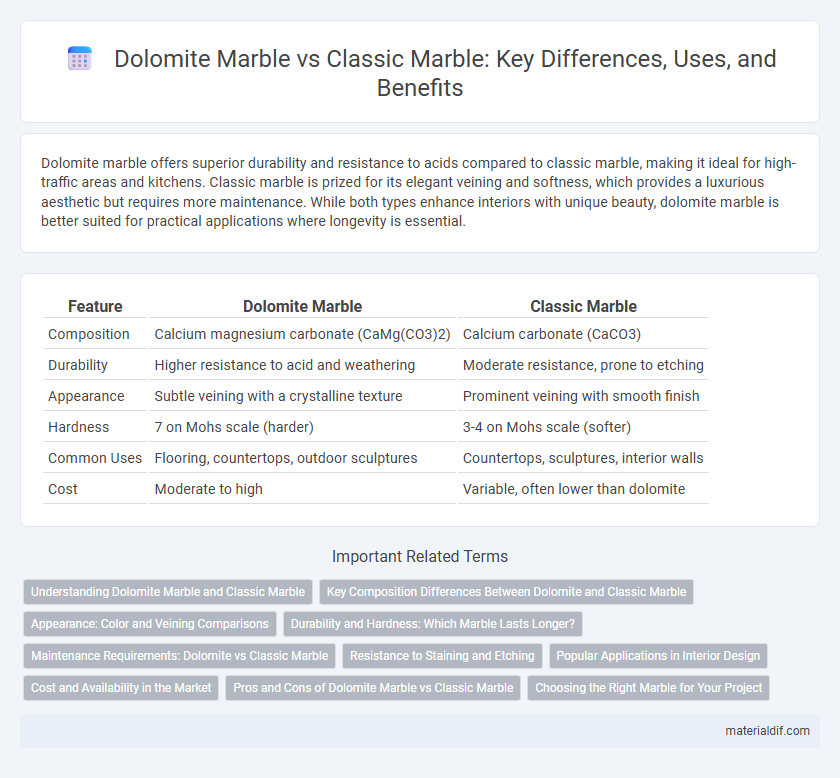Dolomite marble offers superior durability and resistance to acids compared to classic marble, making it ideal for high-traffic areas and kitchens. Classic marble is prized for its elegant veining and softness, which provides a luxurious aesthetic but requires more maintenance. While both types enhance interiors with unique beauty, dolomite marble is better suited for practical applications where longevity is essential.
Table of Comparison
| Feature | Dolomite Marble | Classic Marble |
|---|---|---|
| Composition | Calcium magnesium carbonate (CaMg(CO3)2) | Calcium carbonate (CaCO3) |
| Durability | Higher resistance to acid and weathering | Moderate resistance, prone to etching |
| Appearance | Subtle veining with a crystalline texture | Prominent veining with smooth finish |
| Hardness | 7 on Mohs scale (harder) | 3-4 on Mohs scale (softer) |
| Common Uses | Flooring, countertops, outdoor sculptures | Countertops, sculptures, interior walls |
| Cost | Moderate to high | Variable, often lower than dolomite |
Understanding Dolomite Marble and Classic Marble
Dolomite marble, composed primarily of the mineral dolomite, offers greater resistance to acidic substances and improved durability compared to classic marble, which mainly consists of calcite. Classic marble is prized for its smooth texture and vibrant veining, making it a popular choice for sculptures and architectural features. Understanding these differences helps architects and designers select the ideal material for both aesthetic appeal and functional performance in construction and interior design.
Key Composition Differences Between Dolomite and Classic Marble
Dolomite marble primarily contains calcium magnesium carbonate (CaMg(CO3)2), while classic marble is mainly composed of calcium carbonate (CaCO3). The presence of magnesium in dolomite marble contributes to its increased hardness and resistance to acid erosion compared to classic marble. These compositional differences influence their structural properties, durability, and suitability for various architectural applications.
Appearance: Color and Veining Comparisons
Dolomite marble typically exhibits a softer, more muted color palette with subtle gray or beige tones, while classic marble often features striking white or cream backgrounds with bold, dramatic veining. The veining in dolomite marble tends to be finer and more uniform, creating an elegant and understated appearance compared to the pronounced and varied veins found in classic marble. These differences in color and veining affect design choices, with dolomite offering a more neutral backdrop and classic marble providing a visually impactful statement.
Durability and Hardness: Which Marble Lasts Longer?
Dolomite marble, composed primarily of calcium magnesium carbonate, exhibits higher hardness and enhanced durability compared to classic marble, which is mainly calcite-based. This increased density makes dolomite marble more resistant to scratches, chipping, and acid etching, ideal for high-traffic areas and heavy-use surfaces. Classic marble, while aesthetically appealing, tends to wear down faster under constant stress, making dolomite a longer-lasting choice for construction and decorative purposes.
Maintenance Requirements: Dolomite vs Classic Marble
Dolomite marble requires less maintenance than classic marble due to its higher resistance to scratches and stains, making it ideal for high-traffic areas. Classic marble is more porous and sensitive to acidic substances, necessitating frequent sealing and careful cleaning to prevent etching and discoloration. Regular upkeep for classic marble includes gentle cleaning with pH-neutral products, while dolomite marble can withstand more routine cleaning without compromising its surface integrity.
Resistance to Staining and Etching
Dolomite marble exhibits higher resistance to staining and etching compared to classic marble due to its denser crystalline structure and lower calcite content, making it less reactive to acids and spills. Classic marble, primarily composed of calcite, is more porous and prone to etching from acidic substances such as lemon juice or vinegar. For applications requiring enhanced durability and maintenance ease, dolomite marble offers superior performance against staining and etching challenges.
Popular Applications in Interior Design
Dolomite marble is favored in kitchen countertops and bathroom vanities due to its increased hardness and resistance to scratches compared to classic marble. Classic marble remains popular for flooring, fireplace surrounds, and decorative wall panels, prized for its elegant veining and softer texture. Both types are extensively used in upscale interior design for creating luxurious, timeless spaces with unique aesthetic appeal.
Cost and Availability in the Market
Dolomite marble generally offers a more affordable option compared to classic marble, with prices varying based on regional extraction and quality. Availability of dolomite marble tends to be more consistent due to its abundant natural deposits, making it a preferred choice for large-scale construction projects. Classic marble, prized for its unique veining and colors, often commands higher prices and is less frequently available in bulk, resulting in fluctuating market supply.
Pros and Cons of Dolomite Marble vs Classic Marble
Dolomite marble, known for its higher resistance to acids and stronger durability, offers superior longevity compared to classic marble, which tends to be more porous and susceptible to etching and staining. Dolomite marble's denser composition makes it less prone to wear, ideal for high-traffic areas, while classic marble provides a softer, more elegant appearance with a broader range of colors and veining patterns. The primary downside of dolomite marble is its typically higher cost and more limited aesthetic variety relative to classic marble, which is favored for its timeless beauty despite requiring more maintenance.
Choosing the Right Marble for Your Project
Dolomite marble offers enhanced durability and resistance to acids compared to classic marble, making it ideal for high-traffic or outdoor projects. Classic marble provides a timeless, elegant aesthetic with a wide range of colors and veining patterns, perfect for decorative interiors and flooring. Selecting the right marble depends on the balance between durability needs and the desired visual impact for your specific architectural or design project.
Dolomite Marble vs Classic Marble Infographic

 materialdif.com
materialdif.com